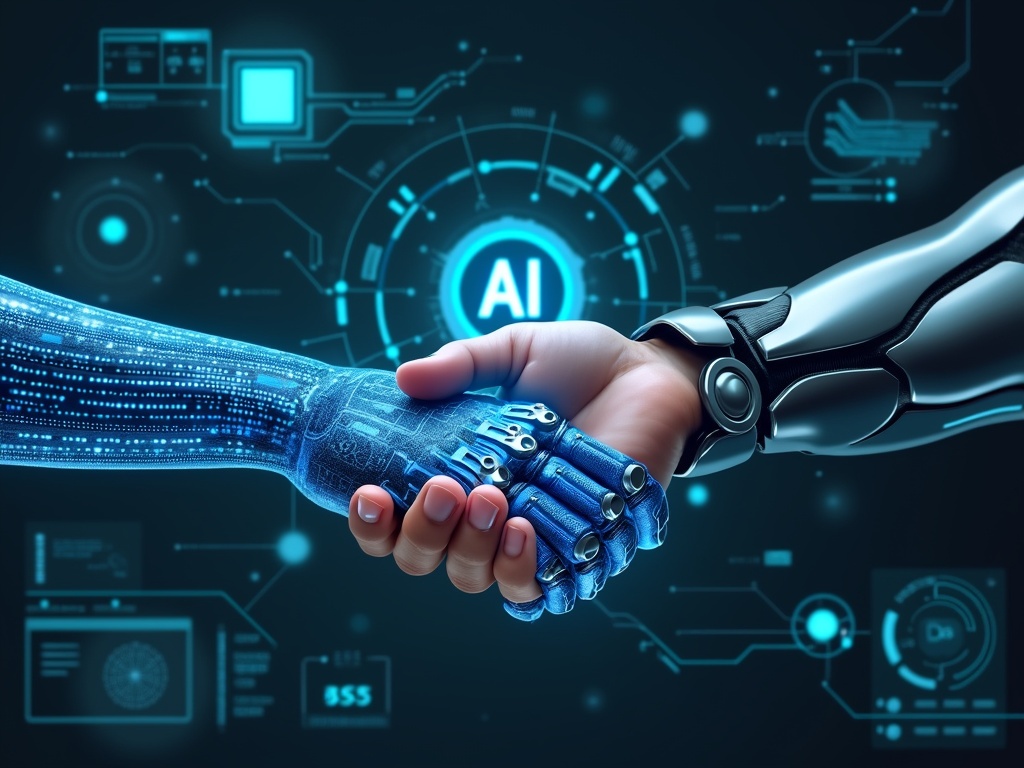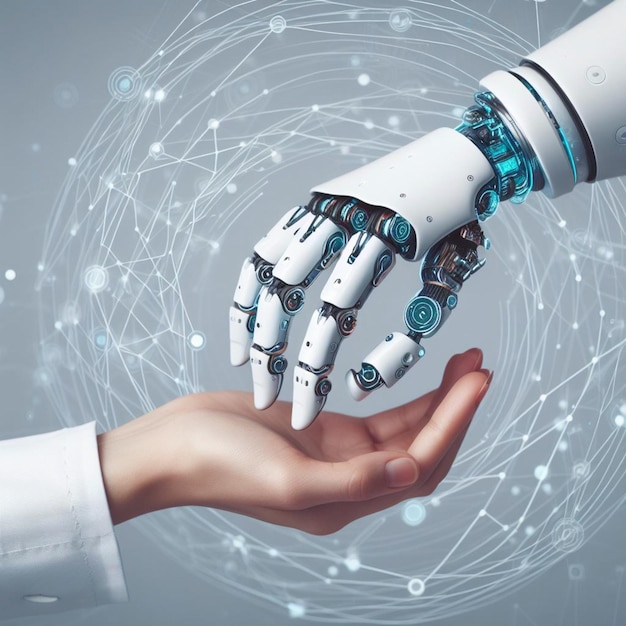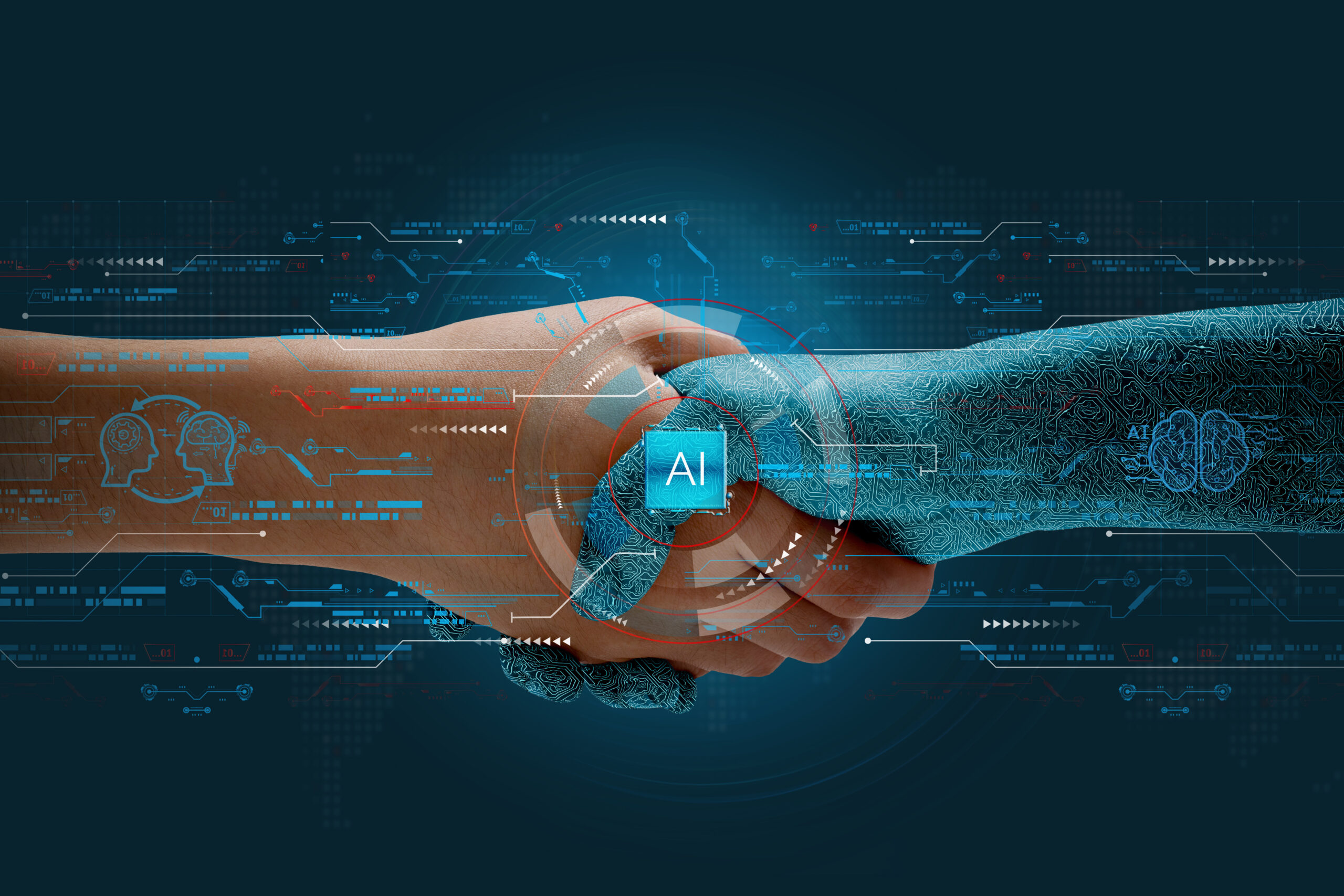Boosting Productivity Through Human-AI Collaboration: Strategies for Success
Imagine walking into your office and having an AI assistant that understands your work style and enhances it. This is the emerging reality of human-AI collaboration transforming workplaces across industries.
Beyond headlines about AI replacing jobs, a more nuanced and powerful story is unfolding. Research shows that the most significant performance improvements come when humans and AI systems work together, combining human qualities like intuition, creativity, and emotional intelligence with AI’s computational power and pattern recognition abilities.
Take Beyond Better Foods, for example, where AI-enhanced communication tools have revolutionized their workflow efficiency. Their Chief Operating Officer found that collaborative AI helped teams access critical information faster and make better-informed decisions, demonstrating how human expertise paired with AI capabilities can multiply productivity.
This isn’t just about faster work—it’s about smarter work. When humans and AI collaborate, teams can reduce errors through AI-driven analysis while maintaining the crucial human element in final decision-making. This partnership allows organizations to tackle complex challenges that neither humans nor machines could solve alone.
As we enter this transformative era, the question isn’t whether AI will change how we work—it’s how we can best harness the synergy between human intuition and artificial intelligence to create more innovative, efficient, and productive workplaces. The future of productivity isn’t about humans versus machines; it’s about humans and machines working together to achieve extraordinary results.
The Role of Collaborative Intelligence


Today’s most groundbreaking achievements aren’t coming from humans or AI working in isolation – they’re emerging from their powerful collaboration. This partnership, known as collaborative intelligence, creates a synergy where human creativity and AI’s analytical prowess combine to push beyond traditional limitations.
At its core, collaborative intelligence represents a fundamental shift in how we approach problem-solving. Rather than viewing AI as a replacement for human workers, this model recognizes that both humans and machines bring unique and complementary strengths to the table. Research shows that hybrid intelligent systems optimize these complementary strengths so that humans and AI together behave more intelligently than either could separately.
Humans excel at qualities that machines still struggle to replicate – emotional intelligence, contextual understanding, creative thinking, and nuanced decision-making. Meanwhile, AI systems bring unprecedented data processing capabilities, pattern recognition, and tireless consistency to tasks. When combined thoughtfully, these strengths create possibilities that were previously unattainable.
Consider the example of complex medical diagnosis, where collaborative intelligence is already showing remarkable promise. While AI can rapidly analyze thousands of medical images and identify subtle patterns, human doctors bring crucial real-world experience, intuition, and the ability to consider each patient’s unique context. Together, they achieve higher accuracy rates than either could alone.
Collaborative intelligence also enables dynamic learning between humans and machines. As AI systems process vast amounts of data and identify patterns, they can surface insights that help humans make better decisions. Simultaneously, human feedback helps AI systems refine their models and adapt to new scenarios. This creates a virtuous cycle of continuous improvement.
Hybrid intelligence systems combine machine and human intelligence to overcome the shortcomings of existing AI systems
ACM Digital Library Research Paper
The impact of this collaboration extends far beyond just enhancing existing capabilities. By combining human insight with machine processing power, organizations can tackle previously insurmountable challenges, from developing new medicines to solving complex climate modeling problems. This represents not just an improvement in how we work, but a fundamental transformation in what we can achieve.
Looking ahead, the development of collaborative intelligence systems requires careful consideration of how to best structure human-AI interactions. Success depends not just on advanced algorithms, but on thoughtfully designed interfaces, clear communication channels, and processes that maximize the strengths of both human and machine intelligence while compensating for their respective limitations.
Enhancing Workflow Efficiency with AI
AI is transforming business processes by automating routine tasks, significantly improving operational efficiency. This shift allows organizations to innovate and work more effectively.
According to IBM research, AI-powered automation can reduce forecasting errors by up to 50% and minimize inventory shortages by 65%. AI processes vast data, identifying patterns that enable accurate predictions and smoother operations.
AI’s impact extends beyond task replacement. It handles repetitive processes like data entry and routine customer inquiries with remarkable consistency and accuracy, reducing errors in critical industries like manufacturing and healthcare.
AI empowers human workers by freeing them from mundane tasks, allowing them to focus on work requiring creativity, emotional intelligence, and strategic thinking. For example, AI can manage basic customer service inquiries, letting human agents address complex cases.
The financial benefits of AI automation are compelling. Streamlined operations and reduced errors lead to substantial cost savings. Companies report significant reductions in processing times, completing tasks in minutes rather than hours or days, enhancing customer satisfaction through faster service delivery.
As AI technologies evolve, their role in workflow efficiency will grow. Organizations embracing AI automation today position themselves at the forefront of operational excellence, ready to thrive in a competitive business landscape. The key is viewing AI as a tool that enhances human capabilities and drives productivity.
Overcoming Challenges in Human-AI Collaboration
The integration of artificial intelligence with human workflows isn’t always seamless. Organizations face significant hurdles when implementing AI collaboration systems, particularly in addressing inherent biases and managing workforce resistance to technological change.
Data biases present a fundamental challenge in human-AI partnerships. AI systems learn from historical data, which often contains embedded societal prejudices and organizational blind spots. When these biases go unchecked, they can perpetuate unfair decision-making patterns and limit the effectiveness of collaborative efforts.
Lacking metaknowledge fundamentally limits how well human decision makers can collaborate with AI and other algorithms
Resistance to change emerges as another critical obstacle. Many professionals harbor concerns about AI replacing their roles or diminishing their value within organizations. This anxiety can lead to reduced engagement with AI tools and missed opportunities for productive collaboration.
To address these challenges effectively, organizations should implement comprehensive bias detection and mitigation strategies. This includes regular audits of AI outputs, diverse team involvement in system development, and transparent documentation of decision-making processes.
Training programs play a crucial role in overcoming resistance. Research shows that when teams understand how to work alongside AI systems rather than viewing them as replacements, collaboration becomes more natural and productive.
Building trust requires clear communication about AI’s capabilities and limitations. Organizations should establish feedback mechanisms where team members can report concerns and suggest improvements to collaborative workflows. This creates a more inclusive environment where both human expertise and AI capabilities are valued.
Success in human-AI collaboration also depends on creating the right organizational structure. Leadership must champion a culture that emphasizes augmentation rather than automation, showing how AI tools enhance human capabilities rather than replace them.
Building a Collaborative AI Strategy
Developing a robust collaborative AI strategy demands more than just adopting the latest tools. Success hinges on thoughtful integration that enhances existing workflows while empowering teams to achieve better outcomes. Here’s how organizations can build an effective collaborative AI framework.
Laying the Foundation for Integration
The journey begins with a thorough assessment of your current workflows and identifying areas where AI can add genuine value. According to Stack Overflow, successful AI integration requires careful consideration of data management, training requirements, and system compatibility before implementation.
Start by conducting a comprehensive workflow audit to pinpoint inefficiencies and bottlenecks where AI intervention could yield the most significant improvements. This initial analysis helps prevent the common pitfall of implementing AI solutions that disrupt rather than enhance existing processes.
Focus on selecting AI tools that align with your team’s specific needs and technical capabilities. Avoid getting caught up in vendor hype—prioritize solutions with proven track records and clear integration pathways with your current systems.
Consider both immediate needs and long-term scalability when evaluating AI solutions. The goal is to build a foundation that can grow and adapt as your organization’s AI capabilities mature.
Developing Your AI Workforce
A successful collaborative AI strategy requires more than just technological infrastructure—it demands a skilled team capable of leveraging these tools effectively. Investment in training and skill development is crucial for maximizing the potential of AI integration.
Create comprehensive training programs that address both technical competencies and the broader implications of AI adoption. Team members should understand not just how to use AI tools, but also their limitations and appropriate use cases.
Engaging a diverse range of stakeholders is critical for optimizing ethical outcomes in AI development. Early identification of stakeholders allows developers to align their processes with relevant ethical guidelines.
Microsoft Research Report on AI Productivity
Foster a culture of continuous learning and experimentation. Encourage teams to share insights and best practices as they discover new ways to leverage AI tools within their workflows. This collaborative approach helps accelerate adoption and innovation across the organization.
Monitoring and Optimizing Performance
Implementation is just the beginning—maintaining an effective collaborative AI strategy requires ongoing monitoring and optimization. Establish clear metrics to track both technical performance and business impact.
Regular assessment of key performance indicators helps identify areas for improvement and ensures AI tools continue to deliver value. Pay particular attention to user adoption rates, process efficiency gains, and overall impact on team productivity.
Create feedback loops that allow team members to share their experiences and suggestions. Their insights are invaluable for fine-tuning AI implementations and identifying opportunities for expansion.
Remember that successful AI integration is an iterative process. Be prepared to make adjustments based on real-world usage patterns and emerging needs. This flexibility ensures your collaborative AI strategy remains effective and aligned with organizational goals over time.
The Future of Work with Human-AI Collaboration


Connecting for a collaborative future with AI. – Via freepik.com
According to recent research, future AI systems will actively exchange knowledge and collaborate with humans in unprecedented ways. This deeper integration is transforming how we work across industries, with 65% of organizations now regularly using AI tools, nearly double the adoption rate from last year.
The emerging landscape of human-AI collaboration extends beyond basic automation. Modern AI assistants are sophisticated partners in creative and analytical tasks, augmenting human capabilities rather than replacing them. From surgeons working with AI-guided diagnostics to lawyers leveraging AI for case research, this symbiotic relationship is redefining professional excellence.
In software development, AI pair programming tools provide real-time code suggestions, accelerating development cycles while maintaining human oversight for critical decisions. This pattern of AI augmentation, where technology enhances rather than replaces human judgment, represents the future of professional work.
Future AI systems will be able not only to communicate with human users and each other but also to efficiently exchange knowledge and wisdom with abilities of cooperation, collaboration, and even cocreating something new and valuable
ACM Digital Library
Multimodal AI systems are emerging as game-changers in workplace collaboration. These advanced platforms can process multiple types of data – text, images, speech, and video – simultaneously, enabling more natural and intuitive human-AI interactions. For instance, professionals can now verbally request complex analyses and receive visual aids alongside detailed text explanations, streamlining decision-making processes.
| Year | AI Adoption Rate |
|---|---|
| 2018 | 50% |
| 2023 | 66% |
| 2024 | 72% |
This technological evolution brings important considerations. Organizations must balance AI integration with human expertise, ensuring that automation enhances rather than diminishes the human element in work processes. The focus should be on creating collaborative environments where AI handles routine tasks while humans drive strategic thinking, creativity, and emotional intelligence – skills that remain uniquely human.
The economic implications of this shift are significant. Research indicates that businesses embracing AI collaboration are seeing meaningful revenue increases, particularly in areas like supply chain management and marketing. Yet success requires more than just implementing technology – it demands a thoughtful approach to change management, skill development, and ethical considerations.
Conclusion and Future Directions in Human-AI Collaboration


Symbolizing unity of humans and artificial intelligence. – Via trueanthem.com
The evolution of human-AI collaboration stands at a pivotal moment, where human ingenuity and artificial intelligence create unprecedented opportunities for innovation and growth. As research demonstrates, organizations achieve the most significant performance improvements when they embrace collaborative intelligence rather than viewing AI as a replacement for human workers.
SmythOS exemplifies this collaborative future by providing a comprehensive platform that addresses current implementation challenges while setting the stage for more sophisticated interactions. Its integrated approach to AI deployment enables organizations to harness the complementary strengths of both human creativity and machine efficiency, creating a synergy that drives productivity to new heights.
Looking ahead, we can expect to see increasingly nuanced forms of human-AI cooperation emerge. These partnerships will likely extend beyond simple task automation to encompass more complex collaborative scenarios where AI systems adapt and learn from human expertise while simultaneously augmenting human capabilities with rapid data processing and pattern recognition.
The workplace of tomorrow will require a delicate balance between maintaining human agency and leveraging AI’s analytical prowess. As organizations navigate this transformation, platforms like SmythOS will play a crucial role in ensuring that human-AI collaboration remains both ethical and productive, while fostering an environment where both human and artificial intelligence can thrive together.
This journey toward enhanced human-AI collaboration isn’t just about technological advancement—it’s about creating a future where technology amplifies human potential rather than diminishing it. By embracing these collaborative possibilities while remaining mindful of ethical considerations, organizations can position themselves at the forefront of a revolution in workplace productivity and innovation.
Last updated:
Disclaimer: The information presented in this article is for general informational purposes only and is provided as is. While we strive to keep the content up-to-date and accurate, we make no representations or warranties of any kind, express or implied, about the completeness, accuracy, reliability, suitability, or availability of the information contained in this article.
Any reliance you place on such information is strictly at your own risk. We reserve the right to make additions, deletions, or modifications to the contents of this article at any time without prior notice.
In no event will we be liable for any loss or damage including without limitation, indirect or consequential loss or damage, or any loss or damage whatsoever arising from loss of data, profits, or any other loss not specified herein arising out of, or in connection with, the use of this article.
Despite our best efforts, this article may contain oversights, errors, or omissions. If you notice any inaccuracies or have concerns about the content, please report them through our content feedback form. Your input helps us maintain the quality and reliability of our information.
